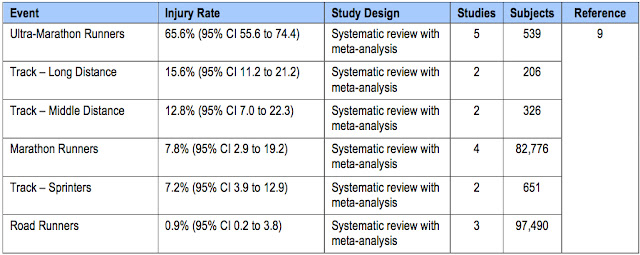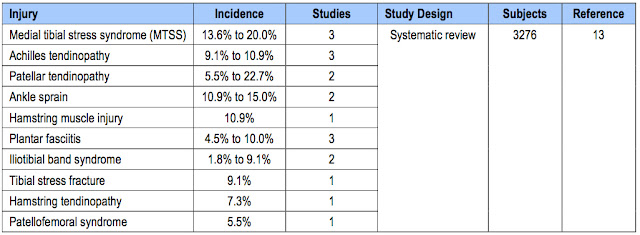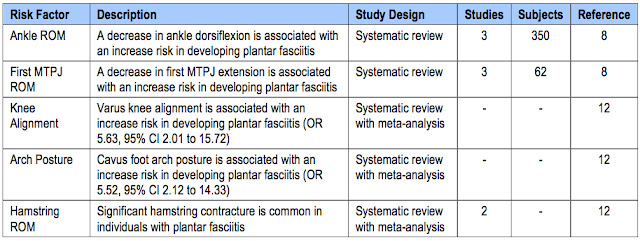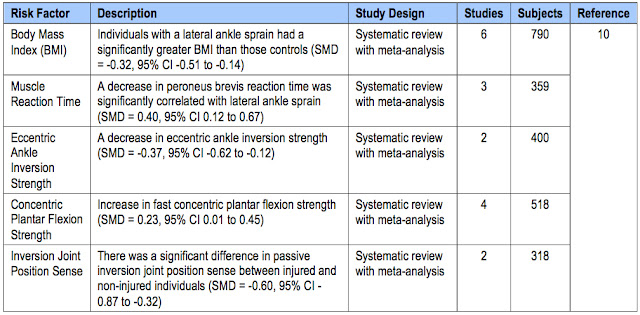PREAMBLE
Please understand that I had difficulty posting the table sizes as they are images added to the posting. Also, the tools provided below were created to be used by physiotherapists. They are a compilation of the risk factors discussed in the tables. The injury risk screening includes the orthopaedic assessments that I personally use when assessing runners. There are a many ways to assess for the same risk factors. Please email me if you would like a link to the original article. Enjoy!
RUNNING-RELATED INJURIES: A LITERATURE REVIEW WITH INJURY RISK SCREENING
Michael Rosenblat
INTRODUCTION
There are a number of assessment screening tools that are used to assess the risk of developing an injury in competitive and recreational sports. The Functional Movement Screen (FMS) was one of the first tools created for this purpose. However, a recent systematic review with meta-analysis has shown that there is little correlation with FMS scores and injury risk (4). This may be due to the fact that the FMS was not created to assess sport specific risk factors. It was created as a general tool to assess common movement patterns.
In order to develop a valid outcome measure that can be used to assess the risk of developing running-related injuries, it is necessary to determine which injuries have the highest prevalence and incidence in runners. It is also beneficial to have a greater understanding of how certain characteristics, including experience and event-type, are associated with the described running-related injuries.
Once there is a clear understanding of the common running-related injuries, it is possible to determine the risk factors that are directly related to each injury. The appropriate variables/risk factors were collected and incorporated into a structured orthopaedic assessment tool and running gait analysis.
The tools provided below have not been assessed for validity or reliability. Additional research would be beneficial to determine the psychometric properties of the assessment tools.
EPIDEMIOLOGY
Injury Rates and Running Experience

Injury Rates by Running Event

Incidence of Running-Related Injuries

Prevalence of Running-Related Injuries

RISK FACTORS
Medial Tibial Stress Syndrome (MTSS)

Achilles Tendinopathy

Plantar Fasciitis

Patellar Tendinopathy

Lateral Ankle Sprain

Iliotibial Band Syndrome

Hamstring Muscle Strain / Tendinopathy

Patellofemoral Syndrome

TRAINING
Volume

BIOMECHANICS
Foot Strike Position

Stride Rate

Barefoot Running

Motion Control Footwear

Injury Risk

RUNNING INJURY RISK SCREENING
Download PDF

RUNNING GAIT ANALYSIS
Download PDF

REFERENCES
1. Aderem J, Louw Q. Biomechanical risk factors associated with iliotibial band syndrome in runners: a systematic review. BMC Musculoskelet Disord 2015;16:356-371.
2. Almeida M, Davis I, Lopes A. Biomechanical differences of foot-strike patterns during running: a systematic review with meta-analysis. J Orthop Sports Phys Ther 2015;45(10):738-755.
3. Cheung R, Wong M, Ng G. Effects of motion control footwear on running: a systematic review. J Sports Sci 2011;29:1311-1319.
4. Dorrel B, Long T, Shaffer S, Myer G. Evaluation of the functional movement screen as an injury prediction tool among active populations: a systematic review and meta-analysis. Sports Health 2015;7(6):532-537.
5. Freckleton G, Pizzari T. Risk factors for hamstring muscle strain injury in sport: a systematic review and meta-analysis. Br J Sports Med 2013;47:351-358.
6. Hall J, Barton C, Jones J, Morrissey D. The biomechanical differences between barefoot and shot distance running: a systematic review and preliminary meta-analysis. Sports Med 2013;43:1335-1353.
7. Hamstra-Wright K, Bliven K, Bay. Risk factors for medial tibial stress syndrome in physically active individuals such as runners and military personnel: a systematic review and meta-analysis. Br J Sports Med 2015;49:362-369.
8. Irving D, Cook J, Menz H. Factors associated with chronic plantar heel pain: a systematic review. J Sci Med Sport 2006;9:11-22.
9. Kluitenberg B, van Middelkoop M, Diercks R, van der Worp H. What are the differences in injury proportions between different populations of runners? A systematic review and meta-analysis. Sports Med 2015;45:1143-1161.
10. Kobayashi T, Tanaka M, Shida M. Intrinsic risk factors of lateral ankle sprain: a systematic review and meta-analysis. Sports Health 2015;Epub ahead of print:1-4.
11. Lankhorst N, Bierma-Zeinstra S, van Middelkoop M. Factors associated with patellofemoral pain syndrome: a systematic review. Br J Sports Med 2013;47:193-206.
12. van Leeuwen K, Rogers J, Winzenberg T, van Middelkoop M. Higher body mass index is associated with plantar fasciopathy/‘plantar fasciitis’: systematic review and meta-analysis of various clinical and imaging risk factors. Br J Sports Med 2015;Epub ahead of print;1-12.
13. Lopes A, Hespanhol L, Yeung S, Costa L. What are the main running-related musculoskeletal injuries? A systematic review. Sports Med 2012;42(10):891-905.
14. Lorimer A, Hume P. Achilles tendon injury risk factors associated with running. Sports Med 2014;44:1459-1472.
15. Mahieu N, Witvrouw E, Stevens V, van Tiggelen D, Roget P. Intrinsic risk factors for the development of achilles tendon overuse injury. A prospective study. Am J Sports Med 2006;34:226-235.
16. Newman P, Witchalls J, Waddington G, Adams R. Risk factors associated with medial tibial stress syndrome in runners: a systematic review and meta-analysis. Open Access J Sports Med 2013;4:229-241.
17. Nielsen R, Buist I, Sørensen I, Lind M, Rasmussen S. Training errors and running related injuries: a systematic review. Int J Sports Phys Ther 2012;7:58-75.
18. Rasmussen C, Nieslen R, Juul M, Rasmussen S. Weekly running volume and risk of running-related injuries among marathon runners. Int J Sports Physiol Perform 2013;8:111-120.
19. Schubert A, Kempf J, Heiderscheit B. Influence of stride frequecy and length on running mechanics: a systematic review. Sports Health 2014;6(3):210-217.
20. Souza R. An evidence-based videotaped running biomechanics analysis. Phys Med Rehabil Clin N Am 2016;27:217-236.
21. Videbaek S, Bueno A, Nielson R, Rasmussen S. Incidence of running-related injuries per 1000 h of running in different types of runners: a systematic review and meta-analysis. Sports Med 2015;45:1017-1026.
22. van der Worp H, van Ark M, Roerink S, Pepping G, van den Akker-Scheek I, Zwerver J. Risk factors for patellar tendinopathy: a systematic review of the literature. Br J Sports Med 2011;45:446-452.
23. van der Worp H, Vrielink J, Bredeweg S. Do runners who suffer injuries have higher ground reaction forces than those who remain injury-free? A systematic review and meta-analysis. Br J Sports Med 2016;Epub ahead of print:1-8.
24. van der Worp M, van der Horst N, de Wijer A, Backx F, Nijhuis-van der Sanden M. Iliotibial band syndrome in runners. A systematic review. Sports Med 2012;42(11):969-992.
25. Wright A, Taylor J, Ford K, Siska L, Smoliga J. Risk factors associated with lower extremity stress fractures in runners: a systematic review with meta-analysis. Br J Sports Med 2015;49:1517-1523.
Michael Rosenblat
http://www.evidencebasedcoaching.ca
Evidence-Based Coaching: Making science work for athletes.
Please understand that I had difficulty posting the table sizes as they are images added to the posting. Also, the tools provided below were created to be used by physiotherapists. They are a compilation of the risk factors discussed in the tables. The injury risk screening includes the orthopaedic assessments that I personally use when assessing runners. There are a many ways to assess for the same risk factors. Please email me if you would like a link to the original article. Enjoy!
RUNNING-RELATED INJURIES: A LITERATURE REVIEW WITH INJURY RISK SCREENING
Michael Rosenblat
INTRODUCTION
There are a number of assessment screening tools that are used to assess the risk of developing an injury in competitive and recreational sports. The Functional Movement Screen (FMS) was one of the first tools created for this purpose. However, a recent systematic review with meta-analysis has shown that there is little correlation with FMS scores and injury risk (4). This may be due to the fact that the FMS was not created to assess sport specific risk factors. It was created as a general tool to assess common movement patterns.
In order to develop a valid outcome measure that can be used to assess the risk of developing running-related injuries, it is necessary to determine which injuries have the highest prevalence and incidence in runners. It is also beneficial to have a greater understanding of how certain characteristics, including experience and event-type, are associated with the described running-related injuries.
Once there is a clear understanding of the common running-related injuries, it is possible to determine the risk factors that are directly related to each injury. The appropriate variables/risk factors were collected and incorporated into a structured orthopaedic assessment tool and running gait analysis.
The tools provided below have not been assessed for validity or reliability. Additional research would be beneficial to determine the psychometric properties of the assessment tools.
EPIDEMIOLOGY
Injury Rates and Running Experience

Injury Rates by Running Event

Incidence of Running-Related Injuries

Prevalence of Running-Related Injuries

RISK FACTORS
Medial Tibial Stress Syndrome (MTSS)

Achilles Tendinopathy

Plantar Fasciitis

Patellar Tendinopathy

Lateral Ankle Sprain

Iliotibial Band Syndrome

Hamstring Muscle Strain / Tendinopathy

Patellofemoral Syndrome

TRAINING
Volume

BIOMECHANICS
Foot Strike Position

Stride Rate

Barefoot Running

Motion Control Footwear

Injury Risk

RUNNING INJURY RISK SCREENING
Download PDF

RUNNING GAIT ANALYSIS
Download PDF

REFERENCES
1. Aderem J, Louw Q. Biomechanical risk factors associated with iliotibial band syndrome in runners: a systematic review. BMC Musculoskelet Disord 2015;16:356-371.
2. Almeida M, Davis I, Lopes A. Biomechanical differences of foot-strike patterns during running: a systematic review with meta-analysis. J Orthop Sports Phys Ther 2015;45(10):738-755.
3. Cheung R, Wong M, Ng G. Effects of motion control footwear on running: a systematic review. J Sports Sci 2011;29:1311-1319.
4. Dorrel B, Long T, Shaffer S, Myer G. Evaluation of the functional movement screen as an injury prediction tool among active populations: a systematic review and meta-analysis. Sports Health 2015;7(6):532-537.
5. Freckleton G, Pizzari T. Risk factors for hamstring muscle strain injury in sport: a systematic review and meta-analysis. Br J Sports Med 2013;47:351-358.
6. Hall J, Barton C, Jones J, Morrissey D. The biomechanical differences between barefoot and shot distance running: a systematic review and preliminary meta-analysis. Sports Med 2013;43:1335-1353.
7. Hamstra-Wright K, Bliven K, Bay. Risk factors for medial tibial stress syndrome in physically active individuals such as runners and military personnel: a systematic review and meta-analysis. Br J Sports Med 2015;49:362-369.
8. Irving D, Cook J, Menz H. Factors associated with chronic plantar heel pain: a systematic review. J Sci Med Sport 2006;9:11-22.
9. Kluitenberg B, van Middelkoop M, Diercks R, van der Worp H. What are the differences in injury proportions between different populations of runners? A systematic review and meta-analysis. Sports Med 2015;45:1143-1161.
10. Kobayashi T, Tanaka M, Shida M. Intrinsic risk factors of lateral ankle sprain: a systematic review and meta-analysis. Sports Health 2015;Epub ahead of print:1-4.
11. Lankhorst N, Bierma-Zeinstra S, van Middelkoop M. Factors associated with patellofemoral pain syndrome: a systematic review. Br J Sports Med 2013;47:193-206.
12. van Leeuwen K, Rogers J, Winzenberg T, van Middelkoop M. Higher body mass index is associated with plantar fasciopathy/‘plantar fasciitis’: systematic review and meta-analysis of various clinical and imaging risk factors. Br J Sports Med 2015;Epub ahead of print;1-12.
13. Lopes A, Hespanhol L, Yeung S, Costa L. What are the main running-related musculoskeletal injuries? A systematic review. Sports Med 2012;42(10):891-905.
14. Lorimer A, Hume P. Achilles tendon injury risk factors associated with running. Sports Med 2014;44:1459-1472.
15. Mahieu N, Witvrouw E, Stevens V, van Tiggelen D, Roget P. Intrinsic risk factors for the development of achilles tendon overuse injury. A prospective study. Am J Sports Med 2006;34:226-235.
16. Newman P, Witchalls J, Waddington G, Adams R. Risk factors associated with medial tibial stress syndrome in runners: a systematic review and meta-analysis. Open Access J Sports Med 2013;4:229-241.
17. Nielsen R, Buist I, Sørensen I, Lind M, Rasmussen S. Training errors and running related injuries: a systematic review. Int J Sports Phys Ther 2012;7:58-75.
18. Rasmussen C, Nieslen R, Juul M, Rasmussen S. Weekly running volume and risk of running-related injuries among marathon runners. Int J Sports Physiol Perform 2013;8:111-120.
19. Schubert A, Kempf J, Heiderscheit B. Influence of stride frequecy and length on running mechanics: a systematic review. Sports Health 2014;6(3):210-217.
20. Souza R. An evidence-based videotaped running biomechanics analysis. Phys Med Rehabil Clin N Am 2016;27:217-236.
21. Videbaek S, Bueno A, Nielson R, Rasmussen S. Incidence of running-related injuries per 1000 h of running in different types of runners: a systematic review and meta-analysis. Sports Med 2015;45:1017-1026.
22. van der Worp H, van Ark M, Roerink S, Pepping G, van den Akker-Scheek I, Zwerver J. Risk factors for patellar tendinopathy: a systematic review of the literature. Br J Sports Med 2011;45:446-452.
23. van der Worp H, Vrielink J, Bredeweg S. Do runners who suffer injuries have higher ground reaction forces than those who remain injury-free? A systematic review and meta-analysis. Br J Sports Med 2016;Epub ahead of print:1-8.
24. van der Worp M, van der Horst N, de Wijer A, Backx F, Nijhuis-van der Sanden M. Iliotibial band syndrome in runners. A systematic review. Sports Med 2012;42(11):969-992.
25. Wright A, Taylor J, Ford K, Siska L, Smoliga J. Risk factors associated with lower extremity stress fractures in runners: a systematic review with meta-analysis. Br J Sports Med 2015;49:1517-1523.
Michael Rosenblat
http://www.evidencebasedcoaching.ca
Evidence-Based Coaching: Making science work for athletes.
Last edited by:
mrosenblat: Feb 12, 16 12:42